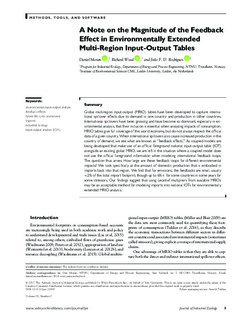| dc.contributor.author | Moran, Daniel | |
| dc.contributor.author | Wood, Richard | |
| dc.contributor.author | Rodriguez, João F. D. | |
| dc.date.accessioned | 2019-02-19T13:18:20Z | |
| dc.date.available | 2019-02-19T13:18:20Z | |
| dc.date.created | 2017-09-26T15:18:22Z | |
| dc.date.issued | 2018 | |
| dc.identifier.citation | Journal of Industrial Ecology. 2018, 22 (3), 532-539. | nb_NO |
| dc.identifier.issn | 1088-1980 | |
| dc.identifier.uri | http://hdl.handle.net/11250/2586309 | |
| dc.description.abstract | Global multiregion input‐output (MRIO) tables have been developed to capture international spillover effects due to demand in one country and production in other countries. International spillovers have been growing and have become so dominant, especially in environmental analysis, that their inclusion is essential when analyzing impacts of consumption. MRIO tables give full coverage of the world economy, but do not always respect the official data of a given country. When international spillovers also cause increased production in the country of demand, we see what are known as “feedback effects.” As coupled models are being developed that make use of an official foreground national input‐output table (IOT) alongside an existing global MRIO, we are left in the situation where a coupled model does not use the official foreground information when modeling international feedback loops. The question thus arises: How large are these feedback loops for different environmental impacts? We look specifically at the amount of domestic production that is embodied in imports back into that region. We find that for emissions, the feedbacks are small, usually <2% of the total import footprint, though up to 6%+ for some countries in some years for some stressors. Our findings suggest that using Leontief multipliers from available MRIOs may be an acceptable method for modeling imports into national IOTs for environmentally extended MRIO analysis. | nb_NO |
| dc.language.iso | eng | nb_NO |
| dc.publisher | Wiley | nb_NO |
| dc.relation.uri | https://onlinelibrary.wiley.com/doi/full/10.1111/jiec.12658 | |
| dc.rights | Navngivelse 4.0 Internasjonal | * |
| dc.rights.uri | http://creativecommons.org/licenses/by/4.0/deed.no | * |
| dc.title | A Note on the Magnitude of the Feedback Effect in Environmentally Extended Multi-Region Input-Output Tables | nb_NO |
| dc.title.alternative | A Note on the Magnitude of the Feedback Effect in Environmentally Extended Multi-Region Input-Output Tables | nb_NO |
| dc.type | Journal article | nb_NO |
| dc.type | Peer reviewed | nb_NO |
| dc.description.version | publishedVersion | nb_NO |
| dc.source.pagenumber | 532-539 | nb_NO |
| dc.source.volume | 22 | nb_NO |
| dc.source.journal | Journal of Industrial Ecology | nb_NO |
| dc.source.issue | 3 | nb_NO |
| dc.identifier.doi | 10.1111/jiec.12658 | |
| dc.identifier.cristin | 1498457 | |
| dc.relation.project | Norges forskningsråd: 531228 | nb_NO |
| dc.relation.project | Norges forskningsråd: 255483 | nb_NO |
| dc.description.localcode | © 2017 The Authors. Journal of Industrial Ecology, published by Wiley Periodicals, Inc., on behalf of Yale University. This is an open access article under the terms of the Creative Commons Attribution License. | nb_NO |
| cristin.unitcode | 194,64,25,0 | |
| cristin.unitname | Institutt for energi- og prosessteknikk | |
| cristin.ispublished | true | |
| cristin.fulltext | original | |
| cristin.qualitycode | 2 | |

